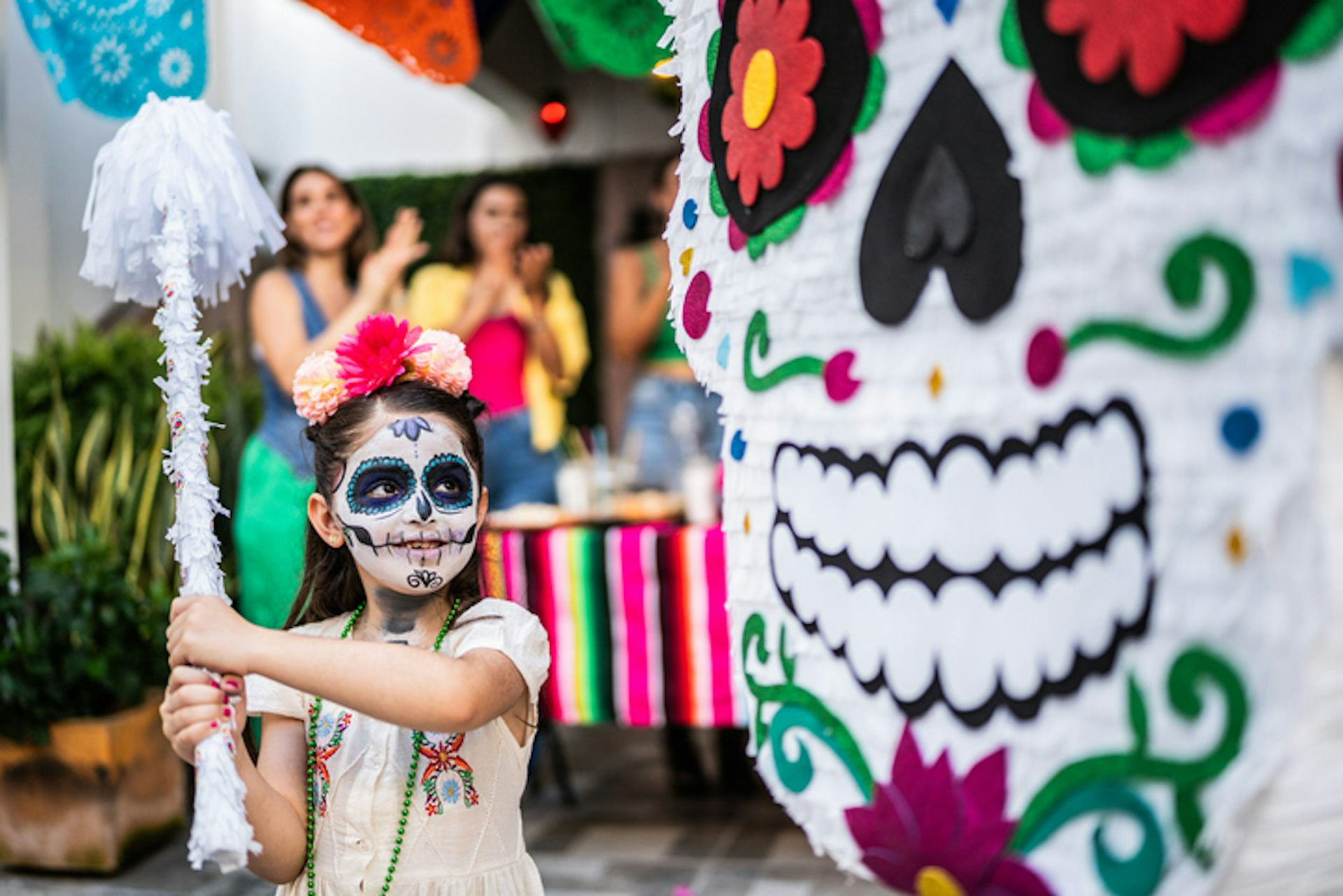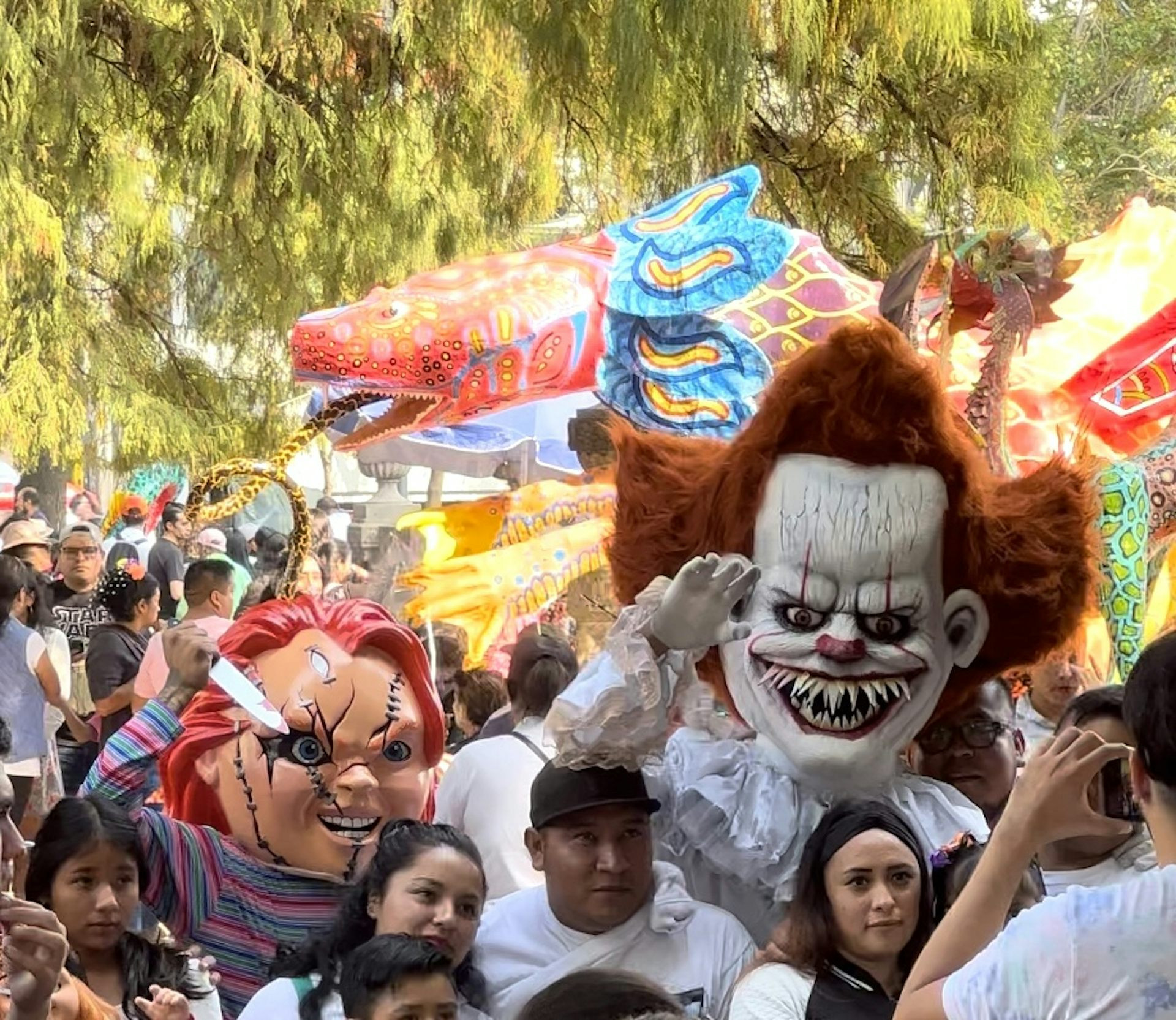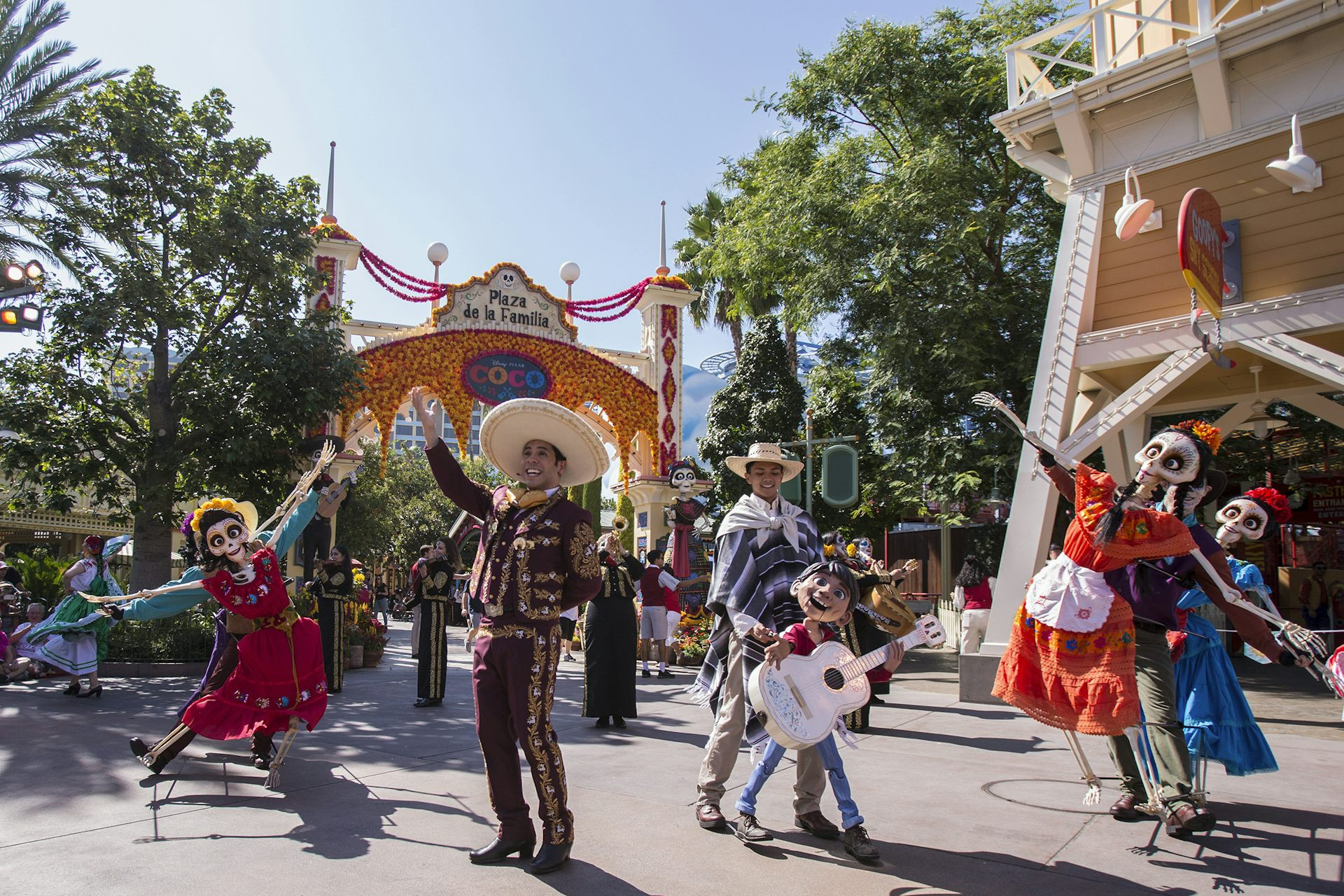Are you curious about “What Is A Mexican Halloween” and how it intertwines with LGBTQ+ culture in Mexico? Gaymexico.net offers an insightful exploration into the traditions, celebrations, and cultural nuances that define this unique time of year, providing a comprehensive guide for LGBTQ+ travelers and enthusiasts alike. Discover how Día de los Muertos is evolving and blending with contemporary influences. Dive into our articles for the ultimate guide to experiencing Mexico’s vibrant cultural landscape with respect and understanding.
Table of Contents
- Is Día de los Muertos a Mexican Halloween? Understanding the Blending of Traditions
- What Are the Origins of the Distinction Between Día de los Muertos and Halloween?
- How Did the 1990s and 2000s Influence the Perception of Día de los Muertos?
- What Role Does Hollywood Play in the Fusion of Halloween and Día de los Muertos?
- How Do Disney Characters Feature in Día de los Muertos Celebrations?
- What Does the Future Hold for Día de los Muertos in the Face of Blending Traditions?
- Where Can LGBTQ+ Travelers Experience Authentic Día de los Muertos Celebrations in Mexico?
- What Are Some Tips for LGBTQ+ Travelers to Respectfully Participate in Día de los Muertos Festivities?
- What Unique Aspects of Día de los Muertos Might Appeal to the LGBTQ+ Community?
- How Does gaymexico.net Enhance the Experience of Día de los Muertos for LGBTQ+ Travelers?
- FAQ Section
1. Is Día de los Muertos a Mexican Halloween? Understanding the Blending of Traditions
Día de los Muertos is often described as a “Mexican Halloween,” but that simplifies a rich, complex tradition; however, it’s becoming more intertwined with Halloween elements, creating a unique cultural hybrid that respects ancestors while embracing contemporary influences. This blending of traditions has led to a vibrant celebration where ancient rituals meet modern festivities.
Día de los Muertos, or Day of the Dead, is a deeply rooted tradition celebrated in Mexico and parts of Latin America, primarily on November 1st and 2nd. It involves honoring deceased loved ones through elaborate altars, vibrant decorations, and communal gatherings. While it shares a late October-early November timeframe with Halloween, the similarities often end there. Yet, the increasing influence of American popular culture, particularly Halloween, is undeniably transforming Día de los Muertos. This transformation sees the integration of Halloween-like costumes, decorations, and even themes, leading to a fusion that some view as cultural enrichment, while others see it as a dilution of tradition. As a result, the question of whether Día de los Muertos is simply a “Mexican Halloween” becomes increasingly complex.
The key is understanding the original intent and evolving practices. Día de los Muertos is fundamentally about remembrance, family connection, and honoring the dead, while Halloween, with its Celtic roots, has evolved into a celebration of the macabre and a night for costumes and candy. According to research from the UCLA Williams Institute, as of July 2023, there’s a growing interest among LGBTQ+ travelers in experiencing authentic cultural events that offer unique perspectives on local traditions. Understanding this blend and celebrating responsibly can create unforgettable experiences. For more insights into LGBTQ+ travel in Mexico, visit gaymexico.net.
 Girl hits pinata at a celebration in Mexico.
Girl hits pinata at a celebration in Mexico.
2. What Are the Origins of the Distinction Between Día de los Muertos and Halloween?
The distinction arose to protect Día de los Muertos’ cultural integrity, particularly as it gained visibility in the U.S., with Latinos emphasizing it as a unique heritage distinct from Halloween’s popular culture. This separation was crucial in preventing misrepresentation and discrimination.
Initially, Día de los Muertos wasn’t widely celebrated publicly among Latinos in the United States. However, the Chicano movement of the 1970s and 1980s brought the tradition to the forefront as a means of empowering Mexican-Americans and celebrating their cultural heritage. As the holiday gained prominence, it became increasingly important to differentiate it from Halloween, especially since many non-Latinos misunderstood the skull and skeleton imagery as witchcraft or simply equated it with Halloween’s macabre themes.
The phrase “Día de los Muertos is not Mexican Halloween” became a protective mantra. It served to educate the broader public about the holiday’s true meaning, shield the community from cultural appropriation, and preserve the tradition’s unique spiritual and cultural significance. Additionally, Mexico’s tourism industry in the 1970s and 1980s actively promoted Día de los Muertos as an authentic national holiday, further reinforcing its separation from Halloween in the eyes of international visitors. According to Human Rights Watch, cultural preservation is vital for minority communities to maintain their identity and combat discrimination.
3. How Did the 1990s and 2000s Influence the Perception of Día de los Muertos?
The 1990s saw the rise of “Día de los Muertos is not Mexican Halloween” as a political statement against U.S. cultural imperialism amid NAFTA’s influx of American consumer goods; however, by the early 2000s, a fusion began as Halloween elements appeared alongside traditional Día de los Muertos items.
The North American Free Trade Agreement (NAFTA), signed in 1994, led to an influx of U.S. consumer goods, media, and popular culture into Mexico. This was perceived by some as “cultural imperialism,” with Halloween’s growing presence seen as a symbol of the United States’ cultural and economic dominance. During this period, the declaration “Día de los Muertos is not Mexican Halloween” became a political statement aimed at preserving Mexican cultural identity in the face of increasing American influence.
However, by the early 2000s, anthropologists began to observe a fascinating fusion of the two holidays. Halloween candy, costumes, and decorations started appearing in Mexican stores and street markets alongside traditional Día de los Muertos materials. Jack-o’-lanterns and spider-web decorations adorned ofrendas, and children increasingly went trick-or-treating dressed as witches, vampires, and monsters. This blending of traditions sparked debate, with some Mexicans denouncing Halloween as a “cultural invasion” or “cultural pollution.”
In 2003, the United Nations officially designated Día de los Muertos as a form of “intangible cultural heritage,” aiming to protect and conserve the holiday from the perceived threats of globalization. Despite these efforts, the fusion of Halloween and Día de los Muertos continued, reflecting a complex interplay of cultural preservation and adaptation.
 Hollywood horror movie images at Day of the Dead festivity in Mexico City.
Hollywood horror movie images at Day of the Dead festivity in Mexico City.
4. What Role Does Hollywood Play in the Fusion of Halloween and Día de los Muertos?
Hollywood significantly contributes to the fusion, with horror movie themes and Disney characters increasingly appearing in Día de los Muertos celebrations, blurring the lines between the two holidays. Films like “Coco” further complicate this distinction.
Hollywood’s influence is evident in the increasing presence of horror movie themes and Disney characters in Día de los Muertos celebrations. Children often trick-or-treat in costume during the Day of the Dead season, and graveyard ofrendas are sometimes decorated with cobwebs, vampires, witches, and pumpkins.
The Gran Desfile de Día de Muertos in Mexico City, which began as a simulation of the parade in the James Bond movie “Spectre,” attracts over a million attendees annually. Participants don not only traditional sugar skull makeup and skeleton attire but also Hollywood horror costumes like Jigsaw from “Saw,” Chucky from “Child’s Play,” and Michael Myers from “Halloween.”
Disney’s influence is also significant. The animated film “Coco,” while celebrating Día de los Muertos, has led to the creation of Halloween costumes based on its characters. These costumes are now popular in Mexico, making it difficult to distinguish between a Halloween costume and a Día de los Muertos costume. This fusion is altering both the festive qualities and ceremonial customs of Día de los Muertos, reflecting a complex interplay of cultural influences.
5. How Do Disney Characters Feature in Día de los Muertos Celebrations?
Disney characters have become increasingly common in Día de los Muertos celebrations, with costumes of superheroes and characters from “Coco” blurring the lines between traditional and modern celebrations. This reflects a broader trend of cultural fusion.
The presence of Disney characters in Día de los Muertos celebrations is a striking example of cultural fusion. It’s not uncommon to see children and adults dressed as Darth Vader, Spiderman, or Jasmine and Aladdin at these events. These costumes appear not only at festive events like the Gran Desfile de Muertos but also at traditional ceremonies. Even at the Panteón de Dolores, you can find Avenger superheroes gathered graveside, making offerings to the dead.
The popularity of Disney-Pixar’s “Coco,” a beloved animated film about Día de los Muertos, has further complicated the distinction between the two holidays. Companies license and manufacture Halloween costumes based on characters from the movie, which are now popular in Mexico. When people dress up as Miguel, Ernesto de la Cruz, or Mama Imelda, it becomes difficult to discern whether they are wearing a Halloween costume or a Día de los Muertos costume.
This trend reflects a broader pattern of cultural exchange and adaptation, where traditional celebrations incorporate elements of popular culture. While some may view this as a dilution of tradition, others see it as a natural evolution that ensures the holiday’s continued relevance and appeal.
 People in costumes dancing with characters inspired by Disney and Pixar
People in costumes dancing with characters inspired by Disney and Pixar
6. What Does the Future Hold for Día de los Muertos in the Face of Blending Traditions?
The future of Día de los Muertos involves ongoing transformation and adaptation as it blends with Halloween, which may be seen as “pollution” by some; however, this evolution ensures the tradition’s survival and continued relevance.
As the fusion between Día de los Muertos and Halloween continues in both rural and urban areas, the holiday’s popular festive qualities and ceremonial customs are being altered. While some cultural conservatives may view this as a “pollution” of a sacred tradition, it’s essential to recognize that transformation and adaptation are inherent to the survival of any tradition.
Día de los Muertos may live eternally, but it will be thanks to the vampire bite of Halloween. This blending of traditions reflects a complex interplay of cultural influences, where the holiday’s traditional elements are reinterpreted and reimagined in the context of contemporary popular culture. This evolution ensures that Día de los Muertos remains relevant and appealing to new generations, while still honoring its deep-rooted cultural and spiritual significance.
7. Where Can LGBTQ+ Travelers Experience Authentic Día de los Muertos Celebrations in Mexico?
LGBTQ+ travelers can find authentic Día de los Muertos celebrations in cities like Oaxaca, Mexico City, and San Miguel de Allende, known for their vibrant cultural scenes and inclusive environments. These destinations offer a blend of traditional and contemporary festivities.
For LGBTQ+ travelers seeking an authentic Día de los Muertos experience in Mexico, several cities stand out for their vibrant cultural scenes and inclusive environments:
- Oaxaca: Known for its rich indigenous culture and strong traditions, Oaxaca offers some of the most authentic Día de los Muertos celebrations in Mexico. The city comes alive with colorful decorations, elaborate altars, and communal gatherings in cemeteries.
- Mexico City: The capital city hosts the Gran Desfile de Día de Muertos, a massive parade that showcases the holiday’s festive spirit. Additionally, many neighborhoods throughout the city organize their own celebrations, offering a diverse range of experiences.
- San Miguel de Allende: This charming colonial town is known for its artistic community and lively cultural scene. Día de los Muertos is celebrated with elaborate altars, processions, and cultural events throughout the town.
In these destinations, LGBTQ+ travelers can immerse themselves in the holiday’s traditions while also enjoying the inclusive and welcoming atmosphere. Local LGBTQ+ organizations and community centers often host events and activities during Día de los Muertos, providing opportunities to connect with the local LGBTQ+ community.
Address: 3255 Wilshire Blvd, Los Angeles, CA 90010, United States. Phone: +1 (213) 380-2177. Website: gaymexico.net.
8. What Are Some Tips for LGBTQ+ Travelers to Respectfully Participate in Día de los Muertos Festivities?
To respectfully participate, LGBTQ+ travelers should learn about the holiday’s traditions, engage with local communities, avoid cultural appropriation, and support local artisans. Showing genuine interest and respect is key to a meaningful experience.
To respectfully participate in Día de los Muertos festivities, LGBTQ+ travelers should keep the following tips in mind:
- Learn about the holiday’s traditions: Take the time to research the history, customs, and symbolism of Día de los Muertos. Understanding the holiday’s significance will help you appreciate its cultural value and avoid unintentional missteps.
- Engage with local communities: Attend local events, visit community centers, and participate in activities organized by local residents. This will give you a deeper understanding of the holiday and allow you to connect with the community.
- Avoid cultural appropriation: Be mindful of your attire and avoid wearing costumes or accessories that could be seen as disrespectful or appropriative. Focus on celebrating the holiday in a way that honors its traditions.
- Support local artisans: Purchase handmade crafts, artwork, and decorations from local artisans. This helps support the local economy and ensures that the traditions of Día de los Muertos are preserved.
- Show genuine interest and respect: Approach the holiday with an open mind and a willingness to learn. Show respect for the traditions, customs, and beliefs of the local community.
By following these tips, LGBTQ+ travelers can respectfully participate in Día de los Muertos festivities and create a meaningful and enriching experience for themselves and the local community.
 Hollywood horror movie images at Day of the Dead festivity in Mexico City.
Hollywood horror movie images at Day of the Dead festivity in Mexico City.
9. What Unique Aspects of Día de los Muertos Might Appeal to the LGBTQ+ Community?
Día de los Muertos’ themes of remembrance, celebration of life, and embrace of diversity resonate with the LGBTQ+ community, offering a space for honoring loved ones and celebrating identity. The holiday’s artistic expression and communal spirit also hold appeal.
Several aspects of Día de los Muertos may be particularly appealing to the LGBTQ+ community:
- Remembrance and celebration of life: Día de los Muertos is a time to remember and celebrate the lives of loved ones who have passed away. This theme resonates deeply with the LGBTQ+ community, many of whom have experienced loss and discrimination.
- Embrace of diversity: Día de los Muertos embraces diversity and celebrates the uniqueness of each individual. This inclusive spirit aligns with the LGBTQ+ community’s values of acceptance and equality.
- Artistic expression: Día de los Muertos is a visually stunning holiday, with colorful decorations, elaborate altars, and intricate artwork. This artistic expression can be particularly appealing to the LGBTQ+ community, who often find creative outlets for self-expression.
- Communal spirit: Día de los Muertos is a communal holiday, with families, friends, and communities coming together to celebrate and honor the dead. This sense of community can be especially meaningful for LGBTQ+ individuals who may have experienced isolation or rejection.
Overall, Día de los Muertos offers a space for the LGBTQ+ community to honor loved ones, celebrate their identities, and connect with others in a spirit of inclusivity and acceptance.
10. How Does gaymexico.net Enhance the Experience of Día de los Muertos for LGBTQ+ Travelers?
Gaymexico.net offers LGBTQ+ travelers comprehensive guides, updated information, and community connections for experiencing Día de los Muertos in Mexico, ensuring a safe, informed, and enriching cultural journey.
Gaymexico.net enhances the experience of Día de los Muertos for LGBTQ+ travelers by providing:
- Comprehensive travel guides: Detailed guides to LGBTQ+-friendly destinations in Mexico, including information on accommodations, nightlife, and cultural attractions.
- Updated event listings: Information on local Día de los Muertos celebrations, including parades, festivals, and community events.
- Community connections: Opportunities to connect with local LGBTQ+ organizations and community centers, providing a welcoming and inclusive environment for travelers.
- Cultural insights: Articles and resources that offer deeper insights into the traditions, customs, and symbolism of Día de los Muertos.
- Safety tips: Information on how to stay safe and avoid discrimination while traveling in Mexico.
By providing these resources, gaymexico.net empowers LGBTQ+ travelers to experience Día de los Muertos in a safe, informed, and enriching way. Discover the best LGBTQ+ experiences in Mexico, including vibrant nightlife, cultural events, and community connections, all in one place.
Ready to immerse yourself in the magic of Día de los Muertos? Explore gaymexico.net for detailed travel guides, event listings, and local LGBTQ+ connections to make your experience unforgettable.
FAQ Section
-
Is Día de los Muertos just a “Mexican Halloween?”
No, Día de los Muertos is a unique tradition focused on honoring deceased loved ones, distinct from Halloween’s themes. However, there’s increasing fusion between the two due to cultural exchange. -
Where can LGBTQ+ travelers experience authentic Día de los Muertos celebrations?
Cities like Oaxaca, Mexico City, and San Miguel de Allende offer vibrant and inclusive environments for experiencing authentic Día de los Muertos festivities. -
How can LGBTQ+ travelers respectfully participate in Día de los Muertos?
By learning about the holiday’s traditions, engaging with local communities, avoiding cultural appropriation, and supporting local artisans. -
What aspects of Día de los Muertos appeal to the LGBTQ+ community?
The themes of remembrance, celebration of life, embrace of diversity, artistic expression, and communal spirit resonate deeply with the LGBTQ+ community. -
How does Hollywood influence Día de los Muertos celebrations?
Hollywood contributes through horror movie themes and Disney characters appearing in celebrations, blurring the lines between traditional and modern festivities. -
What role does Disney’s “Coco” play in Día de los Muertos?
While celebrating Día de los Muertos, “Coco” has also led to the creation of Halloween costumes based on its characters, complicating the distinction between the two holidays. -
What is the significance of ofrendas in Día de los Muertos?
Ofrendas are altars created to honor deceased loved ones, filled with offerings like food, drinks, photos, and personal items that were significant to them. -
How has NAFTA influenced the perception of Día de los Muertos?
NAFTA’s influx of U.S. consumer goods led to some viewing Halloween’s growing presence as “cultural imperialism,” sparking efforts to protect Día de los Muertos. -
What is the Gran Desfile de Día de Muertos in Mexico City?
It’s a massive parade that showcases the holiday’s festive spirit, featuring colorful costumes, floats, and performances, attracting over a million attendees annually. -
How can gaymexico.net help LGBTQ+ travelers experience Día de los Muertos?
gaymexico.net provides comprehensive guides, updated event listings, community connections, cultural insights, and safety tips to ensure a safe and enriching experience.
